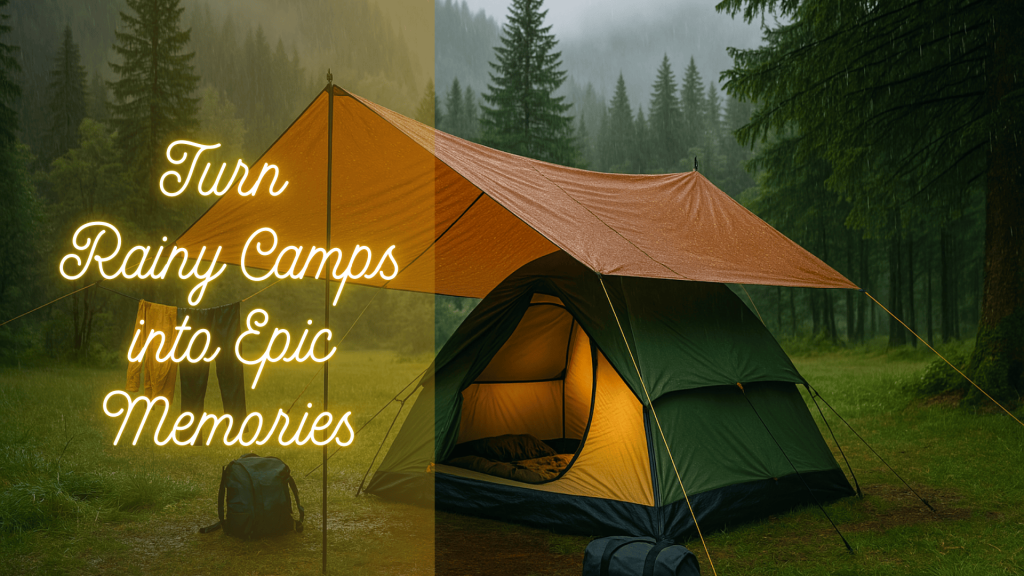Rain shouldn’t wash away your camping plans! Many outdoor lovers miss out on amazing experiences by canceling trips at the first sign of wet weather. The truth?
Camping in the rain offers unique joys—quieter campgrounds, cooler temperatures, and that magical pitter-patter on your tent roof. Plus, wildlife becomes more active, creating perfect viewing opportunities.
We’ll walk you through everything needed to turn potential soggy disappointment into a cozy, memorable adventure. From gear preparation to site selection, cooking methods to staying warm, we’ve got practical tips for campers of all experience levels.
With the right approach, rainy camping transforms from something you merely survive into something you actively seek out.
How to Camp in the Rain?
Camping when the sky opens up doesn’t mean your outdoor plans are ruined. With smart planning and the right gear, rainy camping can be cozy, fun, and might even become your favorite way to connect with nature. The sound of raindrops on your tent, the fresh scent of wet earth, and fewer crowds are just some benefits of braving wet weather.
1. Must-Do Basics to Stay Dry and Happy

Before you pack up and head out, knowing the fundamentals will make all the difference between a soggy disaster and a memorable trip.
- Pack waterproof clothing (jacket, pants, footwear)
- Pick your campsite wisely on high ground away from water collection spots
- Put up a tarp or cover first to create a dry workspace
- Use a quality tent with proper rain protection
- Make a “wet zone” and a “dry zone” in your tent setup
- Bring extra dry clothes and several pairs of socks
- Look at rain as part of the fun, not something that ruins it
2. Smart Tent Setup Tactics
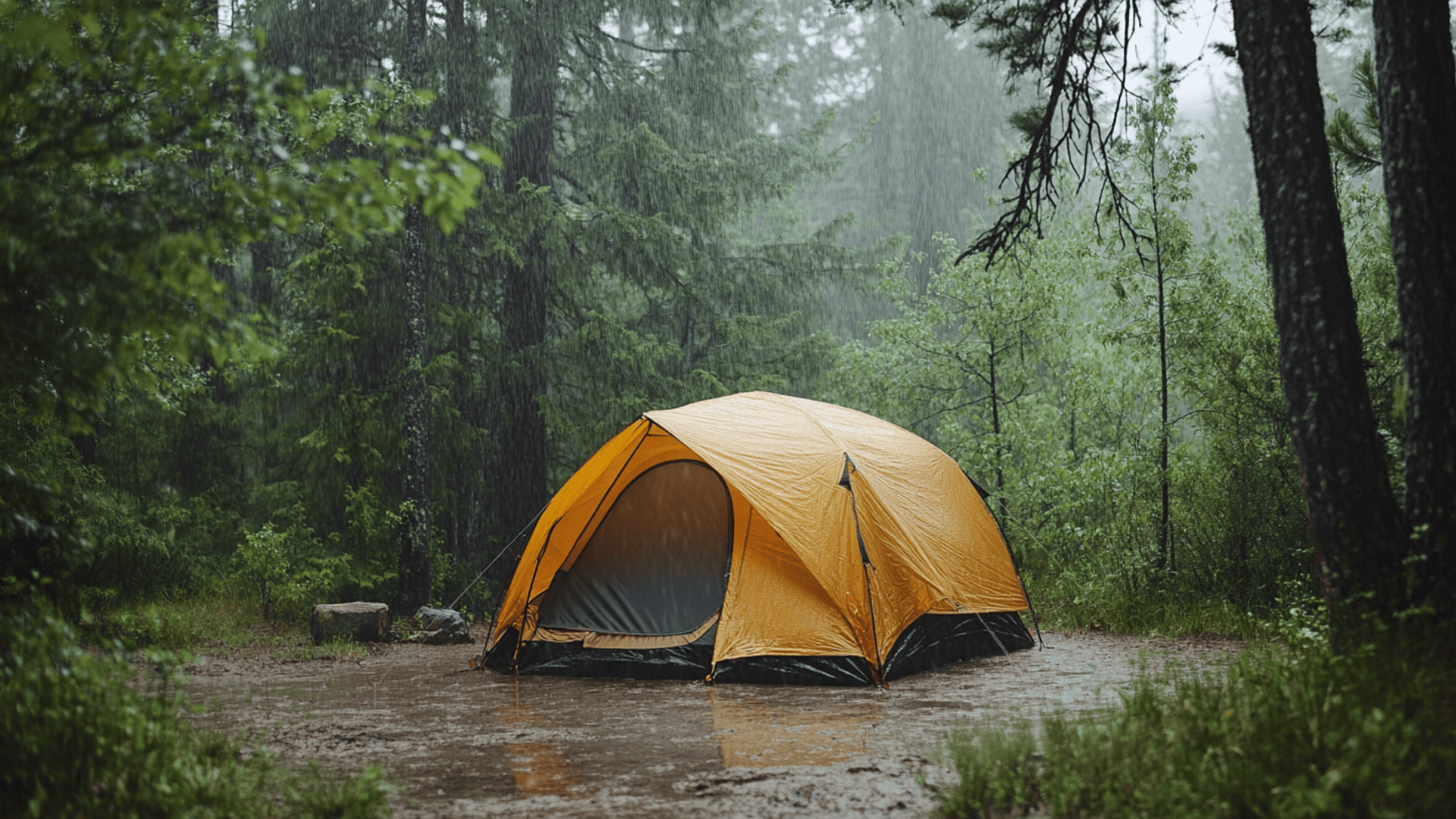
Your tent is your haven during wet weather, so how you set it up matters greatly. Setting up camp in the rain calls for speed and strategy.
- Scout the land for natural protection like trees (but watch for weak branches).
- Face your tent door away from the wind direction to prevent rain from blowing in.
- Dig small trenches around your tent to direct water away—a simple stick works well for this task.
- Don’t rush to finish—proper staking and guy lines make all the difference.
- Pull your rainfly tight with no sagging spots where water might collect.
Pro Tip: Leave some space between the tent body and rainfly for proper air flow to reduce condensation inside.
3. Keeping Your Gear Dry
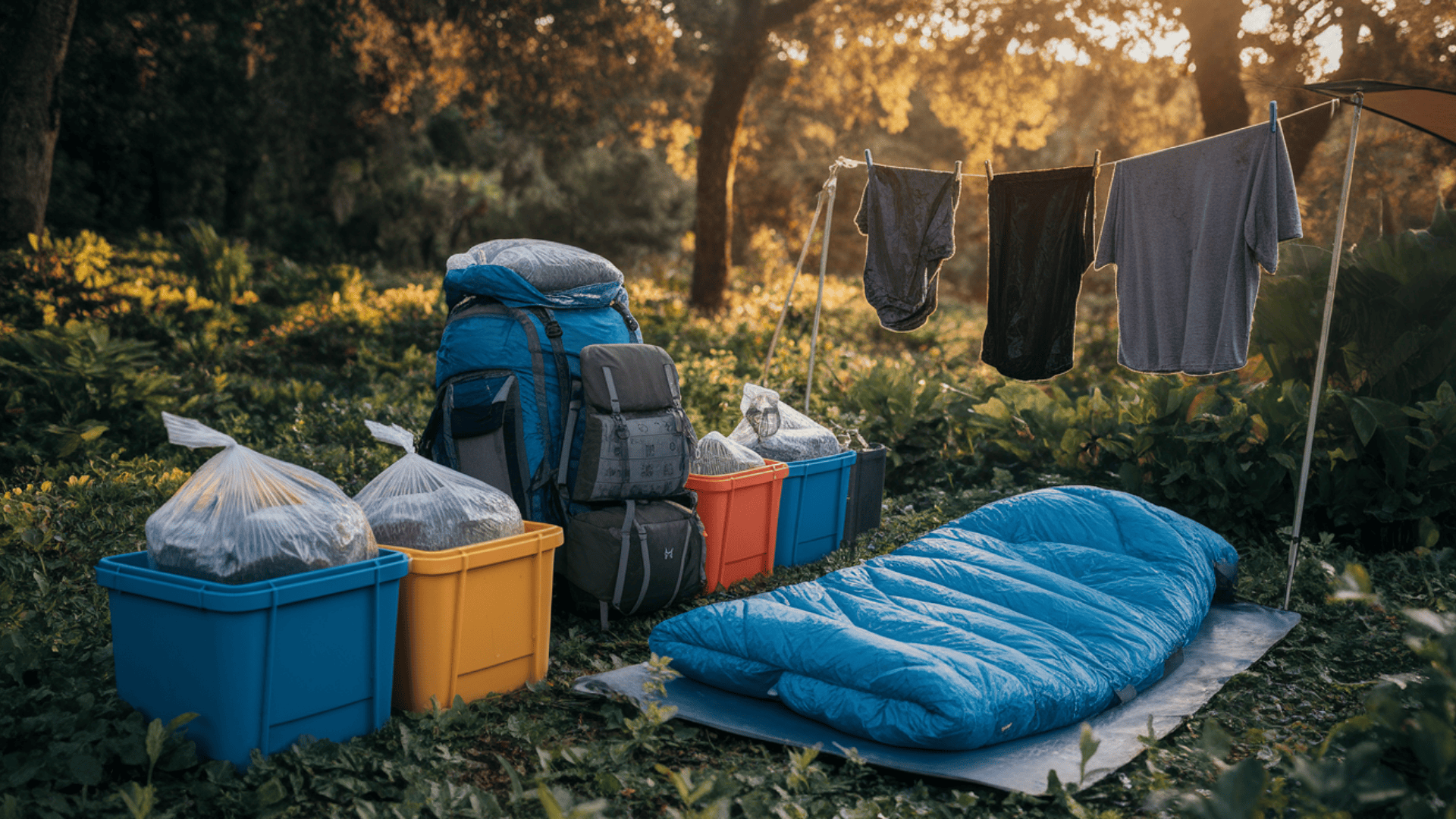
Wet gear equals miserable campers, so protecting your stuff should be a top priority.
- Use waterproof bags or bins for everything
- Keep a special dry bag just for electronics and matches
- Store clothes in sealed plastic bags inside your pack
- Bring small towels to wipe down wet items
- Keep your sleeping bag in a waterproof stuff sack until bedtime
- Hang wet items under a tarp when possible
- Use carabiners to hang items off the ground
4. Cooking in Wet Conditions
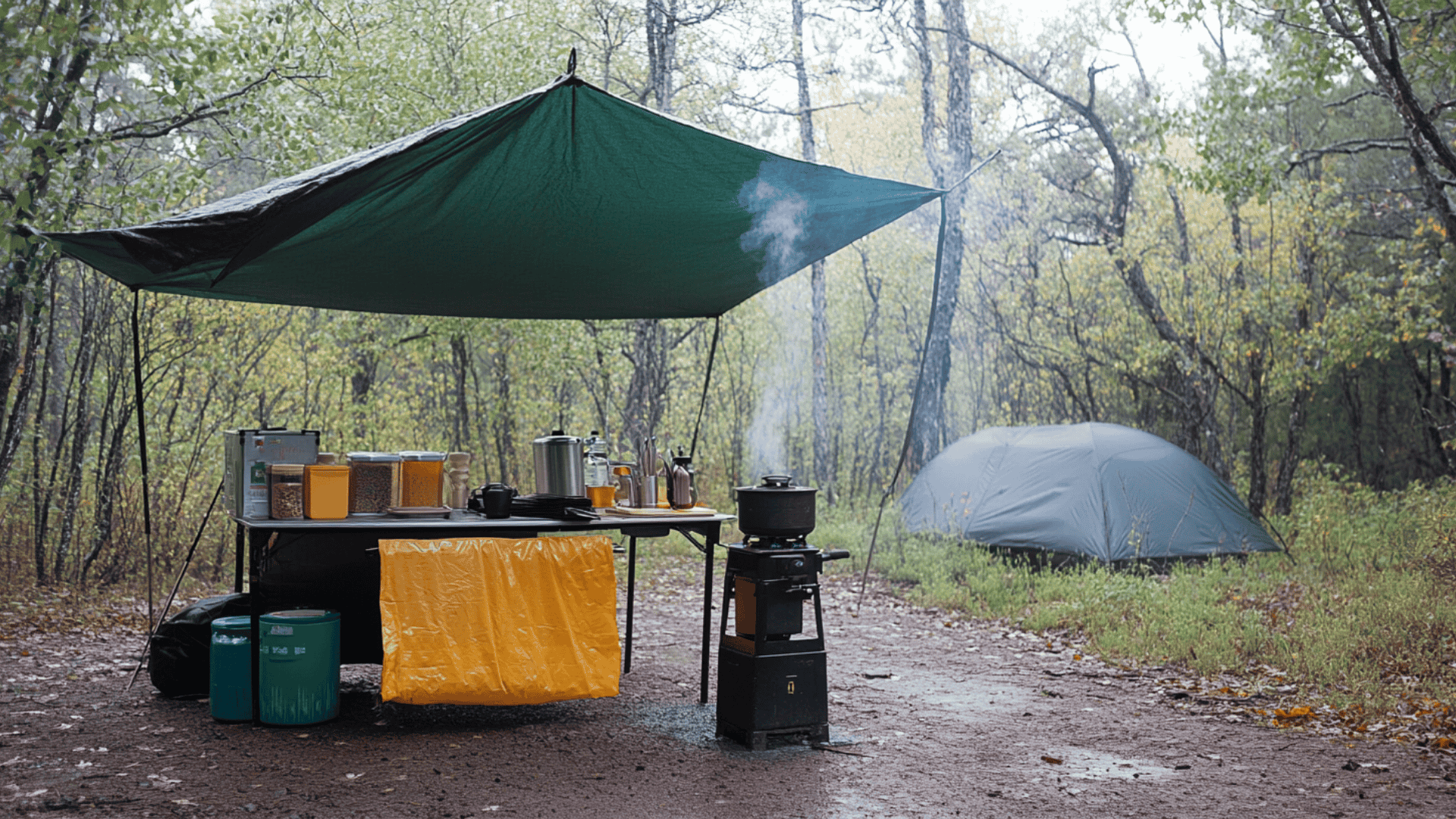
Food tastes even better when you’re outdoors in the rain, but cooking presents unique challenges. Setting up a proper cooking area can turn a potentially frustrating experience into a pleasant one.
Create a rain-free kitchen by hanging a tarp high enough to allow smoke to escape but low enough to block falling rain. Position your cooking spot upwind from your tent to keep smoke away. Pack foods that need minimal prep—think one-pot meals and foods that cook quickly.
- Bring a small camp stove rather than counting on finding dry wood for a fire.
- Pre-cut ingredients at home and store them in sealed containers to limit knife work in wet conditions.
- Don’t forget to bring extra fuel as cooking often takes longer in damp weather.
Keep a dedicated set of dry cooking tools in a waterproof container and clean up promptly after meals to avoid attracting wildlife to your camp.
Gear, Setup, and Comfort Tactics
Getting ready for wet-weather camping takes thought and care. The right tools and methods can turn what might seem like a tough situation into a cozy outdoor stay.
1. Gear Prep Before You Leave

Making sure your equipment is ready before heading out saves headaches when raindrops start falling.
- Check and treat your tent if it’s made of canvas or showing signs of age
- Pack fix-it supplies (tape, seam fixer, extra poles)
- Store all items in waterproof bags and plastic containers
- Make food ahead of time – hot, simple meals work best
- Bring rain gear for pets if they’re coming along
Checking weather reports for your camping area is helpful, but always plan as if rain will come. This way, you’ll never be caught off guard when clouds gather.
2. Setting Up at Camp
How you build your camp can make all the difference between staying comfortably dry or fighting moisture all trip long.
- First thing upon arrival, put up your main cover or group shelter. This gives you a dry spot to work from as you set up the rest of camp. Point tent openings away from wind paths to keep rain from blowing inside.
- Pull all tent lines tight; saggy fabric collects water. Place a ground sheet under your tent (but don’t let it stick out past the edges, or it will channel water underneath). Consider adding another layer inside for extra protection.
- Keep everything off the ground—raise boots, chairs, and gear on small platforms, if possible. Hang a line under your shelter to dry wet clothes and gear.
| RAIN INTENSITY | SITE SELECTION PRIORITY | SHELTER SETUP TIPS |
|---|---|---|
| Light Drizzle | Find natural wind blocks | Basic rainfly extension |
| Steady Rain | Look for slight slopes for drainage | Full tarp setup with side protection |
| Heavy Downpour | Stay far from water bodies, seek high ground | Double-layer protection, trenching |
3. Staying Warm and Dry
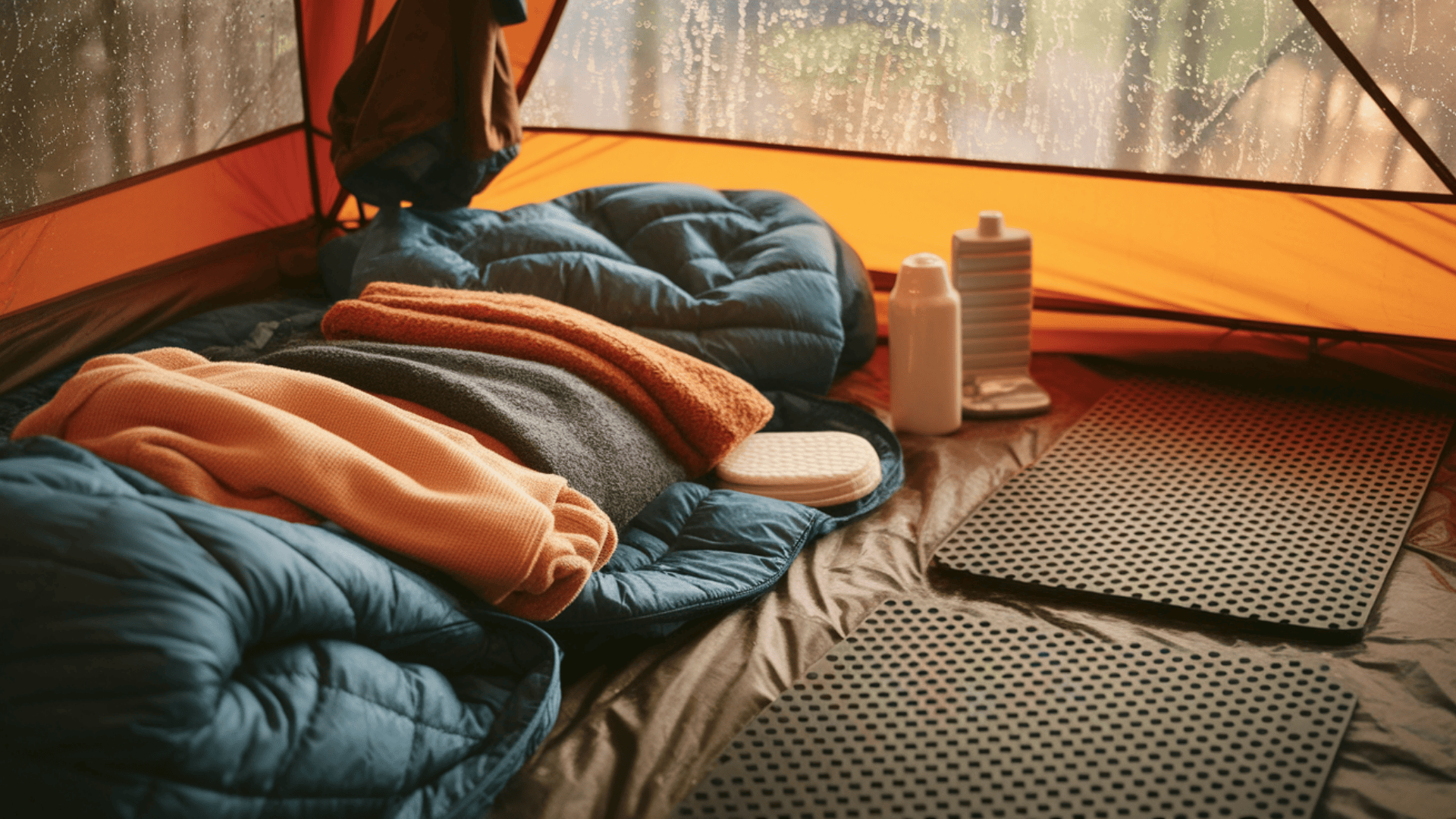
Body comfort makes the biggest difference in how much you’ll enjoy rainy camping.
- Dress in layers that pull moisture away from the skin first, then add insulating middle layers
- Skip cotton clothing completely – choose synthetics or wool that warm even when damp
- Tuck tomorrow’s outfit in your sleeping bag overnight to warm it up
- Use heat packs or hot water bottles for quick warming
- Put bath mats or foam squares at tent entrances to keep inside areas clean
Pro Tip: A spray bottle filled with white vinegar and water (1:3 ratio) helps fight the musty smell that can build up in tents during rainy camping trips. Spray lightly on non-fabric surfaces and wipe dry.
Comfort, Safety, and Fun
When camping in the rain, keeping safe while still having fun takes planning and the right outlook. Balancing protection from the elements with enjoyment of nature’s beauty creates the perfect rainy camping experience that you’ll want to repeat.
1. Safety Tips During Wet Weather
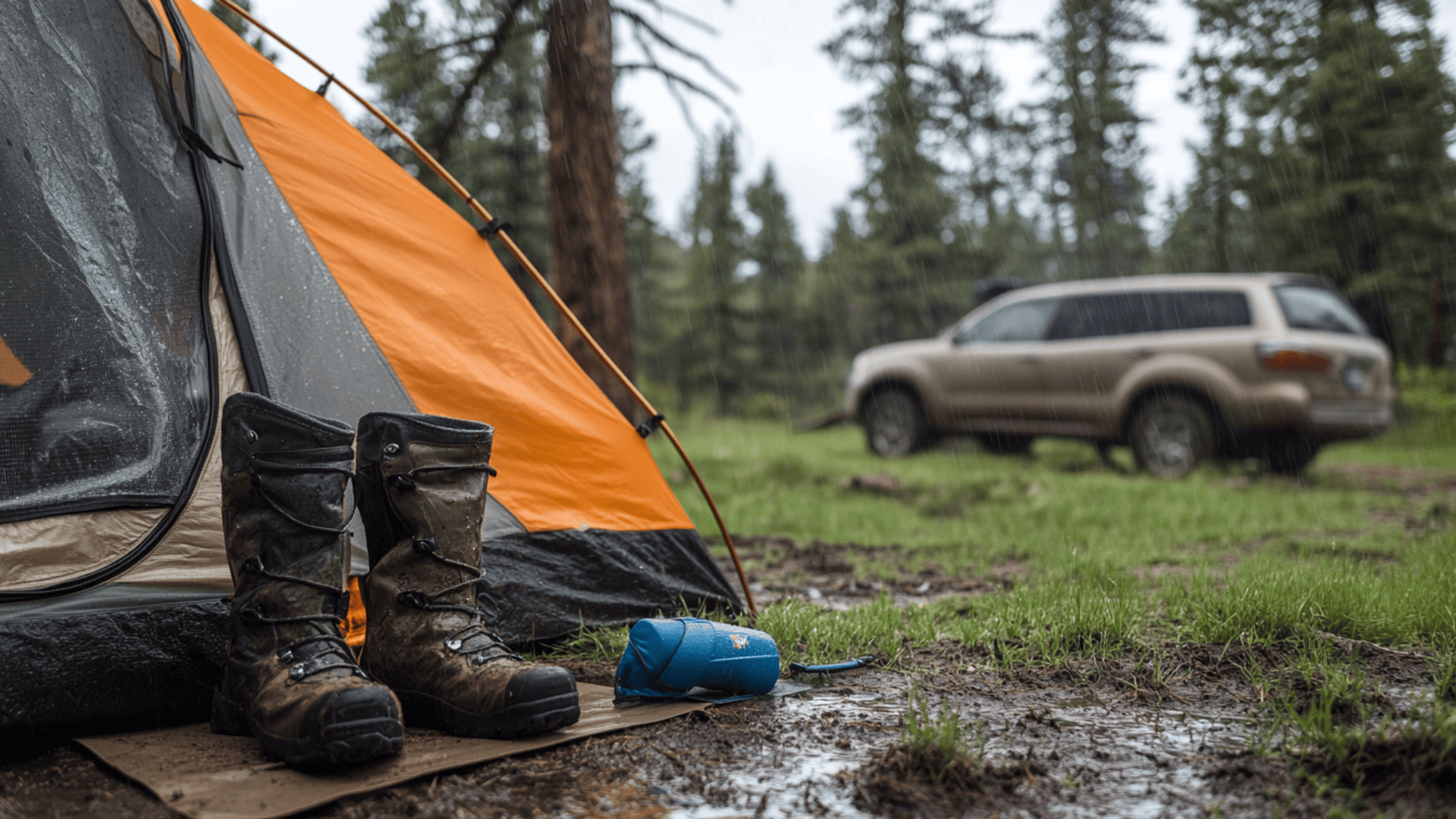
Rain brings its own set of risks that need careful watching. Storm safety comes first when camping in wet weather.
- If you hear thunder, count the seconds until you see lightning – each 5-second count equals about 1 mile of distance. If counts are under 30 seconds, seek shelter in a car or building if possible.
- Be watchful of tree limbs or whole trees that might fall, especially in strong winds or on wet ground. Pick camping spots away from dead trees or hanging branches.
- Keep air flowing through your tent to fight moisture buildup inside. Store fire-starting tools in waterproof cases, and never try to cook under low-hanging tarps where smoke can get trapped.
- Good boots with deep-grip patterns help prevent slips on wet ground. Consider adding shoe covers or leg guards for extra protection in very wet conditions.
2. Mental and Social Resilience
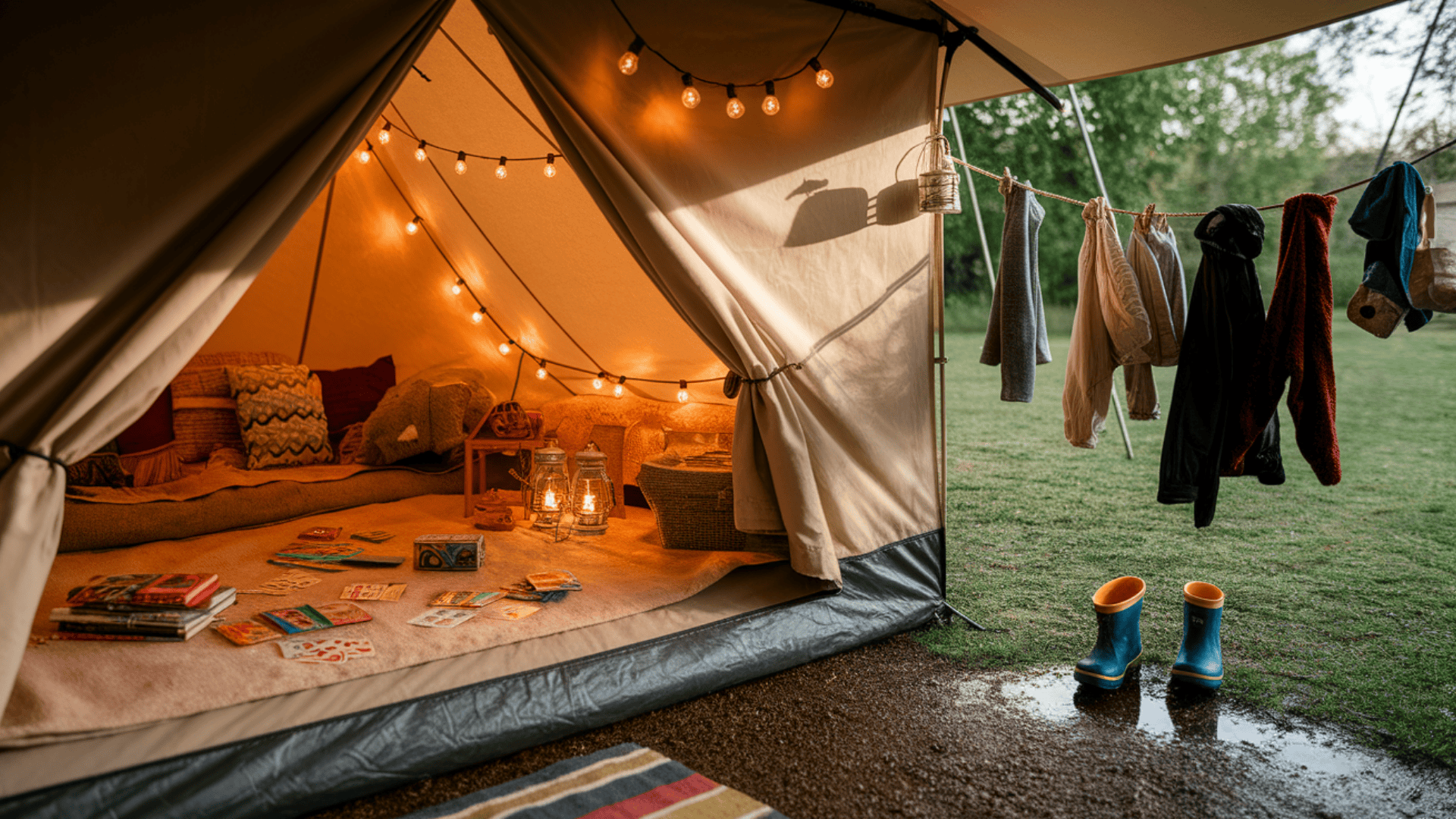
Your attitude and planning for fun can turn a rainy trip into a highlight rather than a letdown.
- Bring mood-lifting lighting like small lanterns or string lights
- Pack indoor activities: card games, small craft projects, books, music
- Let kids play in puddles with proper gear – sometimes getting wet is part of the fun
- When the sun breaks through, rush to dry out everything you can
- Know when to call it – if things get dangerous or truly miserable, it’s okay to pack up early
Fun Fact: Many campers report sleeping better in light rain, thanks to the steady sound on tent fabric. Scientists say rain creates “pink noise” – a natural sound pattern that helps the brain relax more deeply than total silence.
3. Packing Up and Post-Trip Care

How you end your trip affects both your current comfort and your next camping trip. Take down camp in the reverse order you set it up, with your shelter coming down last to give you dry space until the final moment.
- Pack wet items separately from dry ones to handle them properly at home.
- Once home, set up tents and tarps to dry completely – even if they don’t seem wet, hidden moisture can cause mildew.
- Wipe down all gear and air out sleeping bags and pads.
Make notes about what worked well and what you’d change for your next rainy camping trip while the experience is still fresh in your mind.
That’s a Wrap!
Camping in the rain isn’t just possible—it can be downright magical when done right. The key lies in preparation, proper gear, and most importantly, your mindset.
Expect some challenges, but also treasure the unique moments: steaming cups of coffee under a tarp, the symphony of raindrops, and the lush beauty that only appears after a good shower. Rain brings the forest to life in ways sunshine never can.
Take what you’ve learned here, adjust it to fit your camping style, and head out with confidence next time dark clouds gather. The outdoors doesn’t close for rain—and neither should your camping plans.
Pack those waterproof bags, grab your rain jacket, and go make some wonderfully wet memories in nature! Don’t miss out—return for more vacation-planning tips and off-the-beaten-path guides.

